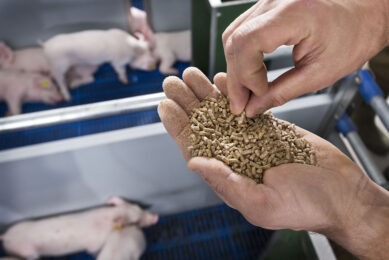Porcine employees

A new, small pig project has been started up in a meadow 10 km from my home. A strip of land in nearby Oosterbeek, the Netherlands is suffering from invasive Japanese knotweed, a plant difficult to remove once it’s growing somewhere. All strategies seem to have failed.
Well, all but one. Pigs have now been trucked in as a last resort solution. Six of them, young females, to be precise, of the Bentheim breed. As omnivores, they should be able to deal with the problem.
I took a look at the project last week. The piglets had their own shelter and could root until they could root no more. Local kids were sitting around the piglets, fascinated by their new pink and black neighbours. As well as adults as more than one car stopped to take pictures. A lady stopped cycling, stared in amazement and wondered if nobody was going to steal the piglets.
Putting pigs to work
What fascinates me, is that pigs have been given a function. They are allowed to do what they are good at – rooting and removing what humans consider unwanted materials. This way history comes full circle as this was a pig’s job in the past in Europe – and still is in other parts of the world. And I don’t mean to come across as negative.
It fits in a general re-appreciation of animal talents. At busy events, the police often prefer equine colleagues as ideal means of transport; canine detectives are ideally equipped for certain drugs discovery jobs and ovine civil servants manage to mow city lawns more accurately than any loud machines can do.
So why should pigs only be destined to live to become meat? Can they be of value to humans before their death? They can – and it’s related to them being the traditional rubbish bin. I recently came across the UK initiative The Pig Idea which promotes this philosophy. Their idea is that much food is wasted because swill can’t be given to livestock – European Union legislation. Bring swill feedback, is their message.
I admit, there are some welfarist groups among the ambassadors, as well as some upmarket restaurants, but let’s look beyond that. The website mentions two advantages for reappreciating swill feed – economic (less feed needs to be bought) and environmental (swill replaces crops that don’t have to be grown).
Swill not a consistent source of nutrition for pigs
Obviously, there are disadvantages of swill feed, otherwise they wouldn’t have been banned.
Swill is not consistent. It’s difficult to determine the exact nutritional value of the feed animals get when the swill is one day this and the next day that. So pigs might not grow uniformly.
More importantly, it is not considered safe for health reasons. It is believed that untreated swill (including animal remains) was the source of contamination for several disease outbreaks, think of BSE (mad cow disease) and Foot-and-Mouth Disease. Recently, swill was also pointed at when African Swine Fever became a problem in Russia. So no surprise that swill feeding was banned in the European Union in 2003.
2050
That is, however, 12 years ago.
Twelve years ago there wasn’t a lot of noise about the year 2050 and its 9.2 billion inhabitants who all need to be fed. The same for the accompanying story about producing more sustainably and more efficiently.
Perhaps a good reason to reassess the reasons for being opposed to swill. Can diseases be eliminated by proper treatment? Can swill feed be presented in a consistent way?
I’m not the only one thinking about the matter, I found. For instance, the EU funded Noshan project – with main input from Belgium, Germany and Spain and further involvement from Italy, France, Turkey and the Netherlands, which looks into how to use feed derived from fruit, vegetables, plants and dairy products.
“The main focus of Noshan is to investigate the process and technologies needed to use food waste for feed production […]. Nutritional value and functionality according to animal needs as well as safety and quality issues will be investigated […].”
Sounds promising – I get visions of pig farms in the vicinity of a waste disposal station to eventually convert green waste into meat.
Long live porcine employees!
Join 18,000+ subscribers
Subscribe to our newsletter to stay updated about all the need-to-know content in the pigsector, three times a week. Beheer
Beheer










 WP Admin
WP Admin  Bewerk bericht
Bewerk bericht